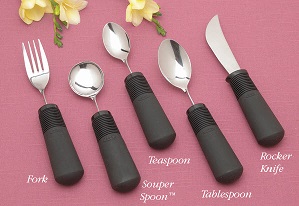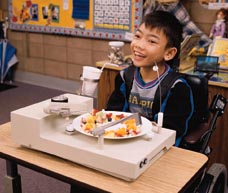Blog Roll: (Contributors)
» Hulet Smith, OT
» Megan Smith, PT
» Mike Price, OT
Topics:
Adaptive Devices
Adult Tricycles
Air Purifier
Allergy
Alternative Communication Devices
Alzheimer's Dementia Products
Aquatic Products
Arthritis Relief Products
Autism
Back Relief
Ball Pit/Pool
Bariatric
Bath Benches
Bathtub Lift
Bed Rails
Bedsores / Decubitus
Bidet
Body Solid Exercise Products
Breast Feeding Products
Bushel Trucks
Cancer
Catheters
CEU
Changing Bench
Child Car Seats
Child Care Products
Christmas Gifts
Clinic/Medical Equipment
Clinical Furniture
Cold and Flu
Communication Devices
Compression Garments
Computer Products
CPAP
Crutches
Daily Assistance Products
Daylight Lamps
Dental Care
Diabetes
Doctor's Office
Dysphagia
Electrodes
Electrolarynx
Emergency Preparedness
Ergonomic Equipment
Exam Tables
Exercise Products
Eyecare
Family Tricycles
First Aid Kits
Floor Scales
Fluidotherapy
Foot Drop
Foul Weather Gear
Furniture
Gait Trainers
General Articles
General Posts
Glassless Mirrors
Hand Sanitizer
Head Protection Helmets
Hearing Impaired
Heart Health
Heating Pad
Hip Fractures
Home Assistance Products
Home/Office Assistance
Hospital Beds
Hoyer Lifts
Hyperbaric chamber
Hyperthermia/Hypothermia
Ice/Hydration Carts
Impotence Products
Incontinence Products
Infection Control Gowns
Inspirational Stories
Lift Chairs
Light Therapy
Low Vision Products
Massage Tables & Chairs
Massage Units
Maternity
Medical Facility Products
Medical Scales
Multi-Sensory Environment
Natural Healing
Nebulizers
Non-Hospital Bedding
Nutritional Supplements
Office Furniture
One-Handed Products
Operating Room Devices
Ostomy Products
Oxygen Compressors
Oxygen Concentrator
Oxygen/Nebulizer Masks
Pain Relief
Paraffin Unit
Patient Lift
Patient Lifts
Patient Restraints
Patient Transfer Systems
Pediatric Bath Chairs
Pediatric Furniture
Pediatric Learning
Pediatric Recreation
Personal Listening Devices
Personal Warming Products
Physical Therapy
Pill Organizers
Pillows
Playground Equipment
Pool Lifts
Press Releases
Procedure Chairs
Pulse Oximeter
Reading Assistance
Reference Materials
Rehab Equipment
Rehabmart News
Rehabmart Newsletter
Respiratory Health
Rollators
Saunas
Scooters
Seniors
Shower Chairs
Shower Commode Chairs
Shower Gurney
Showers Chairs
Side Access Bathtubs
Skin Tear
Special Needs Dinnerware
Special Needs Seating
Special Report Articles
Splints
Sport Injuries
Standers
Staying Home
Stethoscopes
Stimulus Reward Toys
Stress Relief
Stroke
Strollers
Summertime Products and Summertime Fun
Talking Products
Therapy Balls
TheraTogs
Thermometers
Traction Devices & Tables
Treatment Tables
Ultrasound
Vibroacoustic Therapy
Vision Products
Walk-In Bathtub
Walking Aids
Walking Boot
Weighted Wearables
Wheelchair Accessories
Wheelchair Cushions
Wheelchair Lifts
Wheelchair Ramps
Wheelchair Transfer Systems
Wheelchairs
Women's Health
Work Hardening Products
Wound Care
Assistive Eating Devices Help People with Limited Hand Control Enjoy Meals
At first glance, eating seems to be a matter of scooping the food onto a fork or knife. It actually requires countless signals between the hand and the brain to pick up the utensil, hold it in the hand, then lift the food to the mouth before lowering it to get some more food or place it on the table.
For most people, it’s a process that involves little thought. If someone faces a challenge such as compromised hand strength from a stroke or an injury, spasticity from a neuromuscular condition, or Parkinson’s disease or another condition that causes tremors or weakness, it can be difficult for them to feed themselves on their own. Rehabmart carries utensils and devices to help people with the above conditions enjoy their meals independently.

The Good Grips Weighted Utensils feature unique handles made of latex-free material. The 6-ounce weighted built-up handles make gripping easy as well as minimizing tremors. A special twist in the metal shaft makes it possible for the spoons and forks to be bent to the right or left for ease of use. The knife’s rocker shape allows the user to cut meat with a minimum of pressure, making this invaluable for users with compromised arm strength. The utensils may be purchased separately or in a sample kit of all five.

If someone is in the mood for a sandwich, the Sandwich Holder will help them get their egg salad or peanut butter fix. It’s a large plastic grip with a handle that clamps onto the sandwich, allowing the user to raise and lower it with ease. The Holder is latex free and dishwasher safe up to 125 degrees. It can be inserted into a utensil holder, which is sold separately.

For people living with MS, cerebral palsy, or other musculoskeletal or neurological problems that may prevent them from being able to lift utensils altogether, the Winsford Self-Feeder may be a good option. Developed by an engineer whose daughter had a friend with cerebral palsy, the Self-Feeder uses a chin switch and a rocker switch to facilitate self-feeding. An adjustable mechanical arm operated by the chin switch raises and lowers a spoon, allowing users to eat independently at their own pace, perhaps for the first time in their life.
A pusher on the Self-Feeder places the food onto the spoon, and the bowl and plate rotate to allow the user to eat the protein, veggies, and side dishes in the order of their choice. All a caregiver needs to do is make sure that the food is in bite-sized pieces. A drip tray for foods such as soup, cereal, and pasta minimizes the potential spills. The Self-Feeder can be plugged in like any other appliance, or uses the included rechargeable six-volt battery. A Corelle bowl and plate are included, as are a spoon, a food pusher, rocker and chin switches, a drip pan, a drinking glass holder, and carrying case.
These adaptive eating devices are suitable for use in private homes, residential care centers, special education environments, and anywhere a user needs the boost to self-esteem that a sense of independence can bring.
Fran Jablway,
Senior Medical Consumer Writer
and
Hulet Smith, OT
Rehabmart Team Leader & CEO
